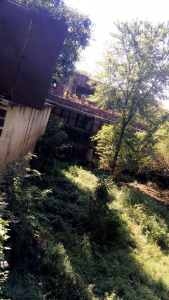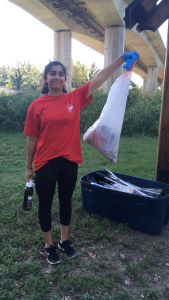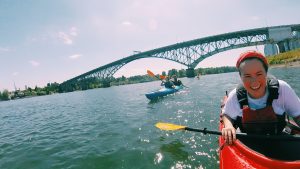The morning I spent picking up trash on Belle Isle with Sanitra was one of the strangest in recent memory. The people and places we encountered throughout the three hour excursion offered sampling of the wide variety of uses people have for the James River Park System. We encountered uses both expected and unexpected, routine and thought-provoking. Most interesting was Belle Isle and therefore the James as the venue for all of these uses to interact, not only with each other but with the physical environment as well.
Firstly, the physical landscape of the island was relevant, as it set the tone for the morning. I’d been to Belle Isle before but never spent this much time exploring it. The scenery offered a strange and somewhat off putting and eery juxtaposition of the natural and man-made. Whereas the natural landscape was relatively well taken care of – the amount of trash we found was not at all competitive with that at Dutch Gap – the man-made structures stand old as old and abandoned. They’re undoubtedly cool to see and to imagine the history behind, but they’re equally undoubtedly ugly and out of place.

The first group of people we encountered seemed to be members of a church or some type of religious community. They were having a quasi-photo shot on the flat rocks, and they were all holding up cardboard signs in the photos. Being curious and nosy, I read as many signs as I could. The one I could see said something along the lines of “I used to be fat and lazy and now I’m spiritual and employed.” Other ones talked about forgiveness from God. They later laid the cardboard signs out to form a large cross and stood around it hand in hand while being videotaped by a drone. The church’s choice of Belle Isle for this type of promotional activity struck me as significant. It may have just been because it was the most scenic backdrop they could think of, but I think there’s also a connection to be drawn between water and rejuvenation, which seemed to be the theme of the morning for them. This connection is especially relevant in the Bible, strengthening the logic behind the the church’s choice of venue.
This gives new purpose to our trash clean up. In addition to the merits of preserving nature for the sake of nature, a noble cause in and of itself, we’re preserving the potential for a meaningful connection to the river, regardless of whether said connection is religious. This sentiment is a hybrid of the sublime and backyard understandings of wilderness. The sublime interpretation suggests wilderness to be the connection between the natural and supernatural, whereas the backyard perspective expands the definition of wilderness to include nature in all forms and landscapes (Cronon, 1995). Belle Isle is not the most awe-inspiring landscape I’ve encountered, but the opportunity to forge a connection with the natural world around you persists there.
In this way, I think the decaying structures left for people to explore have a purpose. They offer insight into the past and provoke contemplation and curiosity of the history of the river, providing the potential for river-goers to have a deeper understanding of and connection to it. We saw the possibility for such a connection in the first chapter of In River Time, in which the author details her obsession with the James River.
I can’t say I’ve fostered as deep a connection with the river as Woodlief has, but I do appreciate and find relevant her discussion of the different “lenses” through which she views the River. In a different form, this is what I learned on Belle Isle that day – the “lenses” were the different groups of people and the ways in which they used the space (Woodlief, 1985).
Other than the church group, there was a woman making miniature teepees out of sticks, rocks, and flowers. Close by there was a table with a poster board detailing the different insect species on Belle Isle. There was also a large number of runners participating in a 5K, and a few pairs of mountain bikers. Every group was using the space in a different way. Additionally, among hundreds of cigarette butts and other litter, Sanitra and I also found four used condoms scattered across the flat rocks. After slight deliberation we picked them up and put them into our trash bags, barely a minute before two kids ran into the area. I see this service as a concrete way of preserving the positive image of the river in those children’s eyes.

On that Saturday, Belle Isle was emblematic of the connectivity rivers have come to symbolize. However the James connects more than just the Blue Ridge mountains to the Chesapeake Bay – it connects people from all walks of life with each other and with the native and nonnative plants and terrestrial and aquatic species that share the space.
We saw this in Portland as well. During our short paddle down the river we encountered a number of its shared users – barges, homeless, and an eagle. This connectivity and plethora of shared uses offers insight into why someone such as Louise Burke would go to such lengths to creative and preserve a public space along the river (Prestidge, 2012). Furthermore, it should encourage our generation to do our part in caring for it.

On the Willamette
Sources
Prestidge, Holly, and Ellen Robertson. “Environmental activist Louise Burke dies.” Richmond Times-Dispatch, www.richmond.com/entertainment/article_3fa9ae7d-4921-5bdb-b941-fd1890ea6e65.html.
Cronon, William. “The Trouble with Wilderness.” Uncommon Ground: Rethinking the Human Place in Nature, 1995, pp. 69-90.
Woodlief, Ann. In River Time. Algonquin Books of Chapel Hill, 1985.
